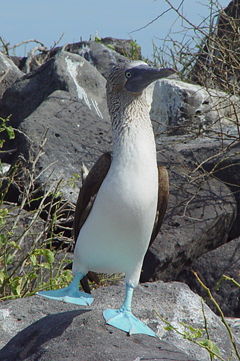Booby
2008/9 Schools Wikipedia Selection. Related subjects: Birds
| Booby | ||||||||||||
|---|---|---|---|---|---|---|---|---|---|---|---|---|
 Blue-footed Booby displaying by raising a foot
|
||||||||||||
| Scientific classification | ||||||||||||
|
||||||||||||
| Species | ||||||||||||
For fossil species, see text |
The boobies are part of the family Sulidae, a group of seabirds, and are closely related to gannets. The true boobies all belong to the genus Sula.
These are large birds with long pointed wings and long bills. They hunt fish by diving from a height into the sea and pursuing their prey underwater. They have facial air sacs under their skin which cushion the impact with the water.
Boobies are colonial breeders on islands and coasts. They normally lay one or more chalky-blue eggs on the ground or sometimes in a tree nest. Their name is possibly based on the Spanish slang term bobo, meaning " dunce", as these tame birds had a habit of landing on-board sailing ships, where they were easily captured and eaten.
Owing to this, boobies are often mentioned as having been caught and eaten by shipwrecked sailors, notably Captain Bligh of the Bounty and his loyalists during their famous voyage after being set adrift by Fletcher Christian and his mutineers.
Systematics and evolution
Five of the six extant Sulidae species called "boobies" are in the genus Sula, while the three gannets are usually treated in the genus Morus. Abbott's Booby was formerly included in Sula but is now placed in a monotypic genus Papasula which represents an ancient lineage perhaps closer to Morus (Friesen et al. 2002). Some authorities consider that all nine species should be considered congeneric, in Sula. However, they are readily told apart by means of osteology, and the distinct lineages of gannets and boobies are known to have existed in such form since at least the Middle Miocene, c.15 mya (Olson 1985).
The fossil record of boobies is not as well documented as that of gannets; possible reasons could be that booby species were less numerous in the late Miocene to Pliocene when gannets had their highest diversity, or that due to the more tropical distribution of boobies, many fossil species have simply not been found yet as most localities are in continental North America or Europe.
GENUS SULA
- Blue-footed Booby, Sula nebouxii
- Peruvian Booby, Sula variegata
- Masked Booby, Sula dactylatra
- Nazca Booby, Sula granti (formerly S. dactylatra granti)
- Red-footed Booby, Sula sula
- Brown Booby, Sula leucogaster
- Sula humeralis (fossil; Middle Pliocene)
- Sula sulita (fossil; Pisco Late Miocene of Peru)
- Sula magna (fossil; Pisco Late Miocene/Early Pliocene of Peru)
Placement of "Sula" ronzoni (Early Oligocene of Ronzon, France) in this genus (and indeed in the Sulidae) is uncertain; it was initially described as a Mergus sea-duck, but this is incorrect. Later, it was proposed to be related to cormorants and the genus Prophalacrocorax was erected for it; this is erroneous (Olson 1985).
